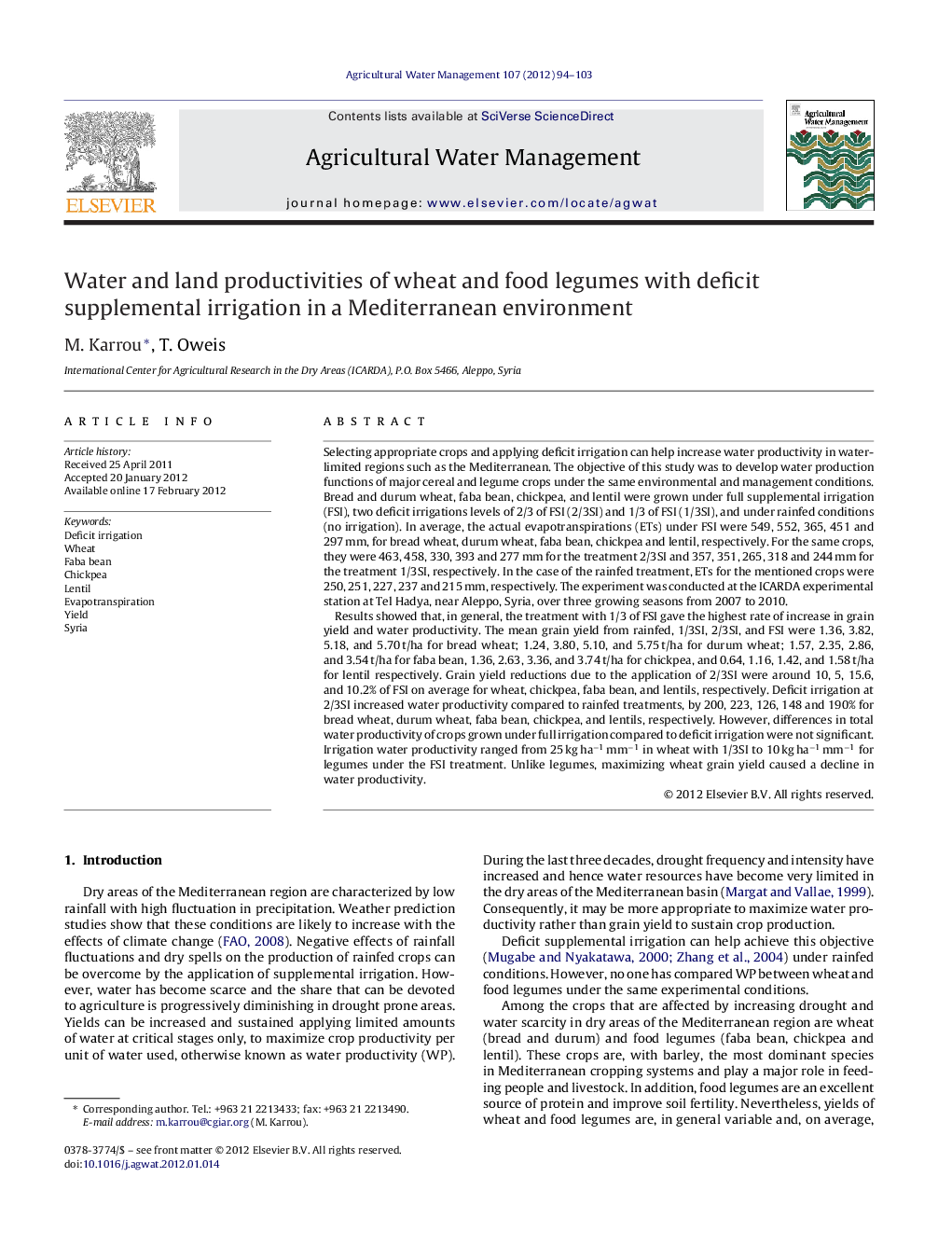| Article ID | Journal | Published Year | Pages | File Type |
|---|---|---|---|---|
| 4479202 | Agricultural Water Management | 2012 | 10 Pages |
Selecting appropriate crops and applying deficit irrigation can help increase water productivity in water-limited regions such as the Mediterranean. The objective of this study was to develop water production functions of major cereal and legume crops under the same environmental and management conditions. Bread and durum wheat, faba bean, chickpea, and lentil were grown under full supplemental irrigation (FSI), two deficit irrigations levels of 2/3 of FSI (2/3SI) and 1/3 of FSI (1/3SI), and under rainfed conditions (no irrigation). In average, the actual evapotranspirations (ETs) under FSI were 549, 552, 365, 451 and 297 mm, for bread wheat, durum wheat, faba bean, chickpea and lentil, respectively. For the same crops, they were 463, 458, 330, 393 and 277 mm for the treatment 2/3SI and 357, 351, 265, 318 and 244 mm for the treatment 1/3SI, respectively. In the case of the rainfed treatment, ETs for the mentioned crops were 250, 251, 227, 237 and 215 mm, respectively. The experiment was conducted at the ICARDA experimental station at Tel Hadya, near Aleppo, Syria, over three growing seasons from 2007 to 2010.Results showed that, in general, the treatment with 1/3 of FSI gave the highest rate of increase in grain yield and water productivity. The mean grain yield from rainfed, 1/3SI, 2/3SI, and FSI were 1.36, 3.82, 5.18, and 5.70 t/ha for bread wheat; 1.24, 3.80, 5.10, and 5.75 t/ha for durum wheat; 1.57, 2.35, 2.86, and 3.54 t/ha for faba bean, 1.36, 2.63, 3.36, and 3.74 t/ha for chickpea, and 0.64, 1.16, 1.42, and 1.58 t/ha for lentil respectively. Grain yield reductions due to the application of 2/3SI were around 10, 5, 15.6, and 10.2% of FSI on average for wheat, chickpea, faba bean, and lentils, respectively. Deficit irrigation at 2/3SI increased water productivity compared to rainfed treatments, by 200, 223, 126, 148 and 190% for bread wheat, durum wheat, faba bean, chickpea, and lentils, respectively. However, differences in total water productivity of crops grown under full irrigation compared to deficit irrigation were not significant. Irrigation water productivity ranged from 25 kg ha−1 mm−1 in wheat with 1/3SI to 10 kg ha−1 mm−1 for legumes under the FSI treatment. Unlike legumes, maximizing wheat grain yield caused a decline in water productivity.
► We compare wheats and food legumes under different water regimes. ► We obtain a water productivity of 12 kg ha−1 mm−1 at wheat yields of 5.4–4.6 t/ha. ► Yields of food legumes increase without water productivity decrease. ► Deficit irrigation saves large amounts of water without significant yield decrease. ► Deficit irrigation requires water policy changes.
